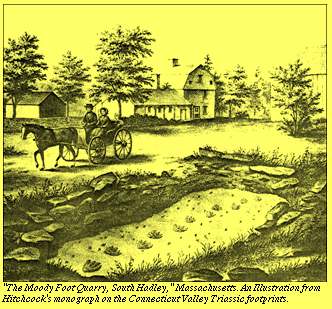 

Dinosaur tracks were observed by prehistoric peoples who evidently regarded them with interest and sometimes carved their own symbols alongside tracks (Leonardi 1984). However the science of vertebrate ichnology dates back only a little over 150 years. We know that dinosaur tracks were observed by Pliny Moody as early as 1802, in the Connecticut Valley, and described by Reverend Edward Hitchcock, Professor of Natural Theology and Geology at Amherst College, in 1836. Although Hitchcock is famous for assigning many to Omithichnites, or stony-bird tracks, he and his contemporaries also recognized the affinities of many other trackmakers, as in Sauroidichnites (see quotation above). The accompanying figure of Otozoum moodi from the original 1802 locality represents a problematic trackmaker assigned by Hitchcock to the Amphibia and by subsequent workers to the Prosauropoda and the Pseudosuchia. In Europe a different situation existed. By 1836 non-dinosaurian reptile tracks of Permo-Triassic age had already been described, and Cretaceous dinosaur remains had been described as fossil reptiles. By 1863, the year of Hitchcock's death, Cretaceous tracks from England had been discovered, scrutinized and assigned with some confidence to Iguanodon (see quotations by Tagart 1846 and Jones 1862). Although the class Dinosauria had been established in 1841 by Richard Owen, Hitchcock never lived to see a pre-Cretaceous dinosaur described or realize that skeletal remains would eventually be unearthed in the track bearing Jurassic strata he knew so well. In the latter part of the 19th century, when a wealth of dinosaur skeletal material was unearthed,
the study of fossil footprints was all but abandoned. Even in the early part of the 20th century, when
the rate of discovery of dinosaur skeletal remains slowed somewhat, the study of footprints was
revived as a parttime activity by only a few workers, notably Richard Swann Lull, Charles Sternberg,
Roland T. Bird and Barnum Brown. Consequently the late 20th century revival of interest in dinosaur
tracks is unprecedented and long overdue. Although vertebrate ichnology is breaking new ground in
this new age of dinosaur research, after a century of neglect, ichnologists still rely on the valuable
contributions of many of the early contributors to the field. References: |